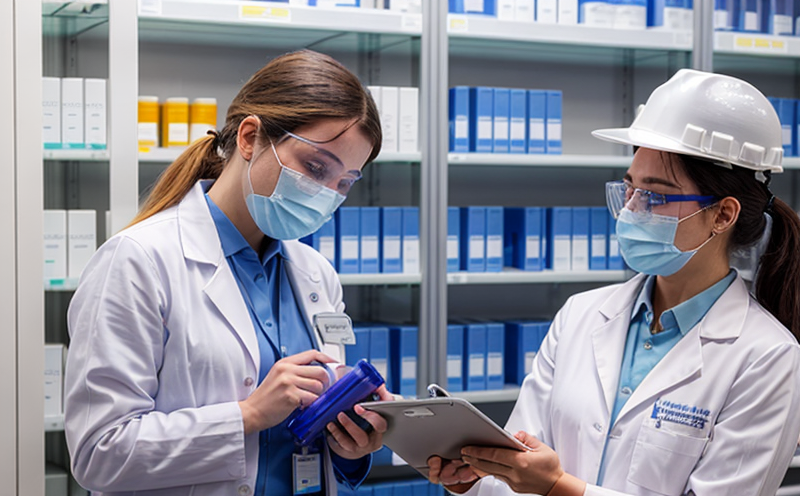
-
Consumer Product Safety-
Certification for Safety in Pharmaceuticals and Drug Products-
Certification for Biopharmaceutical Safety
We provide comprehensive solutions designed to help our clients mitigate risks, enhance performance, and excel in key areas such as quality, health & safety, environmental sustainability, and social responsibility.
Discover
For many years, our organization has been operating successfully, boasting modern laboratories that meet international standards. These laboratories are equipped with the latest technology devices and equipment, and we have built a strong team of experienced and trained personnel to operate them.
DiscoverWelcome to Eurolab, your partner in pioneering solutions that encompass every facet of life. We are committed to delivering comprehensive Assurance, Testing, Inspection, and Certification services, empowering our global clientele with the ultimate confidence in their products and processes.
Discover
-
Consumer Product Safety-
Certification for Safety in Pharmaceuticals and Drug Products-
Certification for Biopharmaceutical SafetyCertification for Biopharmaceutical Safety: A Comprehensive Guide
The biopharmaceutical industry has witnessed tremendous growth in recent years, driven by advancements in technology and a growing demand for innovative treatments. However, with this growth comes increased scrutiny on safety protocols, quality control measures, and regulatory compliance. In this article, we will delve into the importance of certification for biopharmaceutical safety, discuss key aspects, and provide detailed information through bullet point explanations.
What is Biopharmaceutical Safety?
Biopharmaceutical safety encompasses a broad range of aspects, including:
The primary goal of biopharmaceutical safety certification is to ensure that an organizations manufacturing processes, documentation, and personnel meet regulatory requirements.
2. What are some key aspects of biopharmaceutical safety?
Key aspects include Good Manufacturing Practice (GMP), Quality Control, Risk Management, and Regulatory Compliance.
3. How often should audits be performed to maintain certification?
Audits should be performed at regular intervals, typically every 6-12 months, depending on the organizations size, complexity, and regulatory requirements.
4. What are some common hazards associated with biopharmaceutical manufacturing?
Common hazards include equipment failure, contamination, incorrect labeling, and personnel errors.
5. How can an organization demonstrate compliance with regulatory requirements?
An organization can demonstrate compliance by maintaining accurate records, adhering to SOPs, and implementing risk management strategies.
6. What is the role of training in biopharmaceutical safety certification?
Training plays a critical role in ensuring that personnel involved in manufacturing are adequately trained and competent.
7. How can an organization identify areas for improvement during an audit?
Areas for improvement can be identified through document review, process observation, and interviews with personnel.
In conclusion, biopharmaceutical safety certification is essential to ensure compliance with regulatory requirements, maintain product quality, and protect public health. By understanding the key aspects of biopharmaceutical safety, organizations can take proactive steps to prevent potential hazards and ensure the integrity of their products.

Food Safety and Testing
Food Safety and Testing: Ensuring the Quality of Our Food As consumers, we expect our food to be sa...

Agricultural Equipment Certification
Agricultural equipment certification is a process that ensures agricultural machinery meets specific...

Battery Testing and Safety
Battery Testing and Safety: A Comprehensive Guide As technology continues to advance, battery-power...

Renewable Energy Testing and Standards
Renewable Energy Testing and Standards: Ensuring a Sustainable Future The world is rapidly transiti...

Energy and Sustainability Standards
In today’s rapidly evolving world, businesses face increasing pressure to meet global energy a...

Product and Retail Standards
Product and Retail Standards: Ensuring Quality and Safety for Consumers In todays competitive marke...

Railway Industry Compliance
Railway Industry Compliance: Ensuring Safety and Efficiency The railway industry is a critical comp...

Environmental Impact Assessment
Environmental Impact Assessment: A Comprehensive Guide Environmental Impact Assessment (EIA) is a c...

Electrical and Electromagnetic Testing
Electrical and Electromagnetic Testing: A Comprehensive Guide Introduction Electrical and electrom...

Fire Safety and Prevention Standards
Fire Safety and Prevention Standards: Protecting Lives and Property Fire safety and prevention stan...

Environmental Simulation Testing
Environmental Simulation Testing: A Comprehensive Guide In todays world, where technology is rapidl...

Automotive Compliance and Certification
Automotive Compliance and Certification: Ensuring Safety and Efficiency The automotive industry is ...

Trade and Government Regulations
Trade and government regulations play a vital role in shaping the global economy. These regulations ...

NEBS and Telecommunication Standards
Network Equipment Building System (NEBS) and Telecommunication Standards The Network Equipment Bu...

Hospitality and Tourism Certification
Hospitality and Tourism Certification: Unlocking Opportunities in the Industry The hospitality and ...

Consumer Product Safety
Consumer Product Safety: Protecting Consumers from Harmful Products As a consumer, you have the rig...

Electromechanical Safety Certification
Electromechanical Safety Certification: Ensuring Compliance and Protecting Lives In todays intercon...

Construction and Engineering Compliance
Construction and Engineering Compliance: Ensuring Safety, Quality, and Regulatory Adherence In the ...

Cosmetic Product Testing
The Complex World of Cosmetic Product Testing The cosmetics industry is a multi-billion-dollar ma...

Pressure Vessels and Installations Testing
Pressure Vessels and Installations Testing Pressure vessels are a critical component of various ind...

Industrial Equipment Certification
Industrial equipment certification is a critical process that ensures industrial equipment meets spe...

IT and Data Center Certification
IT and Data Center Certification: Understanding the Importance and Benefits The field of Informatio...

Healthcare and Medical Devices
The Evolution of Healthcare and Medical Devices: Trends, Innovations, and Challenges The healthcare...

Lighting and Optical Device Testing
Lighting and Optical Device Testing: Ensuring Performance and Safety Lighting and optical devices a...

Chemical Safety and Certification
Chemical safety and certification are critical in ensuring the safe management of products and proce...

Pharmaceutical Compliance
Pharmaceutical compliance refers to the adherence of pharmaceutical companies and organizations to l...

Transportation and Logistics Certification
Transportation and Logistics Certification: A Comprehensive Guide The transportation and logistics ...

MDR Testing and Compliance
MDR Testing and Compliance: A Comprehensive Guide The Medical Device Regulation (MDR) is a comprehe...

Military Equipment Standards
Military Equipment Standards: Ensuring Effectiveness and Safety The use of military equipment is a ...

Aviation and Aerospace Testing
Aviation and Aerospace Testing: Ensuring Safety and Efficiency The aviation and aerospace industr...